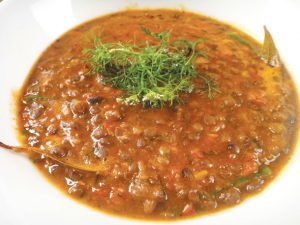Mama’s Punjabi Recipes: Sabat Massar Di Dal (Whole Masoor Lentils)
Saved under Community, Current Stories, Recipe Corner
Tags: Baytown, Clear Lake, Cypress, Desi news, Greater Houston, Houston, Houston Desi news, India, Indian American community, Indian News, Indians in America, Indo-American News, Katy, Mama’s Punjabi Recipes, NRI, pearland, Sabat Massar Di Dal, south asia, South India, Sugar Land, Texas, USA, Whole Masoor Lentils
Dals (lentils) are the mainstay of many Indian diets, especially those who are vegetarian or eat little meat. The provide 3.5 times the amount of protein in rice and 2.5 times that of wheat though boiled dal only contains 9% protein by weight, 70% water, 20% carbohydrates (including 8% fiber) and 1% fat. All dals are also rich in B vitamins, thiamine and folic acid as well as minerals like iron and zinc.
Each region of India has its own style and recipe for dal, made according to local tastes. Nowhere will you find the heartiness and full flavor taste of dals as you will in the Punjab. Punjabi dals are known for their smooth, thick texture and the perfect blend of spices. They are not runny or thin and the hot tardka – blend of hot oil, spices, onions, garlic and sometimes hing (asafetida, an Aryuvedic medicine that relieves gas) – stirred into the cooked dal lets off a sizzle that demands attention, especially as it fills the air with an exciting aroma.
Many people in India make dals in pressure cookers and they have brought this method to their new homes in America too. But, in our ancestral homes in Jhung and Lyallpur in West Punjab there were no pressure cookers and we used to make dal in a large patila (pot) simmered for an hour or more over a slow to medium flame. Very often, the dal made in a cooker gets overcooked and comes out like soup! Dal should be cooked so that you can spot the grain and scoop it up with a little turri (curry).
Dals come in a rainbow of colors and tastes. There is the green moong dal; the yellow pea like channa, toor (also called arar dal) and dhuli (skinless) moong; the black cylindrical urad (known in Punjabi as mahn); the red flat sabat massar; the brown round maut. Punjabis usually stick to the whole moong, whole mahn or split mahn and channa (also called chole ki dal).
There are about 50 varieties of dals (also called pulses) and they come either whole skin (sabat) or split skinless (dhuli).
Skinless (dhuli) dals cook faster than those with the skin which have a high fiber content and a nuttier, earthier taste.
According to Punjabi tradition, sabat massar dal is eaten only in the cold months for the energy and warmth it gives especially when eaten with chawal (rice). Massar dal cooks very easily in a pot rather than in a pressure cooker where it dissolves into soup.
Ingredients:
250gm sabat massar dal (whole masoor lentils)
2 cups pani (water)
2 tbspn olive oil
2 cloves of lasan (garlic) – peeled and chopped, or use powdered garlic
1 medium adrak (ginger) – peeled and chopped, or use powdered ginger
1 tspn garam masala
5 stalktops fresh dhania (coriander) – pinch off the leaves and cut into pieces
Spices (to taste): lal mirch (red pepper); namak (salt); haldi (turmeric)
Directions:
1.Place the masar dal in a bowl and wash it thoroughly in cold water, then rinse it out.
2.Bring the 2 cups of water to a boil over high heat. Pour in the masar dal into the pot, cover, and add the haldi, ginger and salt and let it come to a second boil then reduce the heat to medium.
3.If the water boils off before the dal becomes tender and not too thick, then add some more and let it continue to boil for about 20 minutes till the dal is tender but not soft. Keep a frequent eye on the dal to make sure it does not become soupy.
4.Heat the oil in a small karai or wok and add the garlic and brown it a little. When roasted and the smell of the pieces starts to come through, take off the heat and drop the masala into the pot of cooked dal and stir to mix well.
5.Sprinkle the top of the dal with garam masala and the cut coriander leaves above.
MAMA’S TIP OF THE WEEK
TAKE CARE, DALS GETS THICKER WHEN COOLED DOWN
One of the most common complaints that young, inexperienced cooks have when making dals is that they make then just right for the immediate use, but find that, soon after they take cool down, the dal gets thicker and hard to eat with roti and doesn’t mix well with rice. That’s because the dal just soaks up the water in which it has been cooked.
It is best to cook dal so that it is a little thinner when first taken off the stove. That way, it’ll still be okay for a second helping later. But, if you keep the dal in a fridge for use later, it will certainly be much thicker. In that case, thin it out by adding only boiled – not cold – water.

Shakuntla Malhotra is a skilled cook of Punjabi dishes made in the old-fashioned style that she learnt as a young woman in her ancestral home in Lyallpur (since renamed Faisalabad), India before it became part of Pakistan after the Partition in 1947. People have often admired her cooking for its simplicity and taste that comes with each mouthful. Even in her mid-eighties, she continues to cook daily and agreed to share some of her delectable Punjabi recipes

